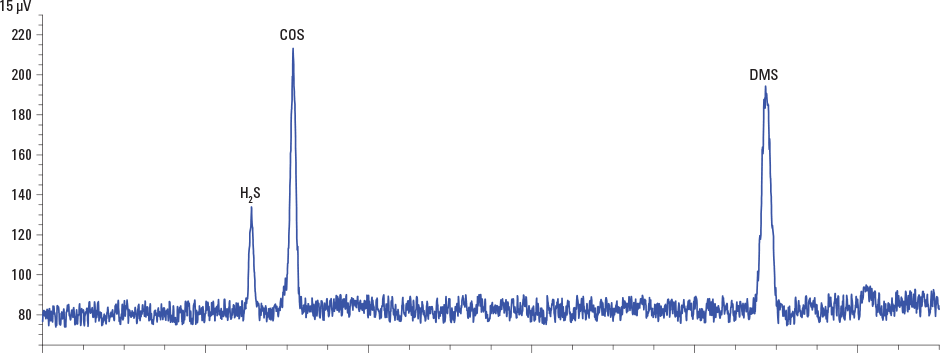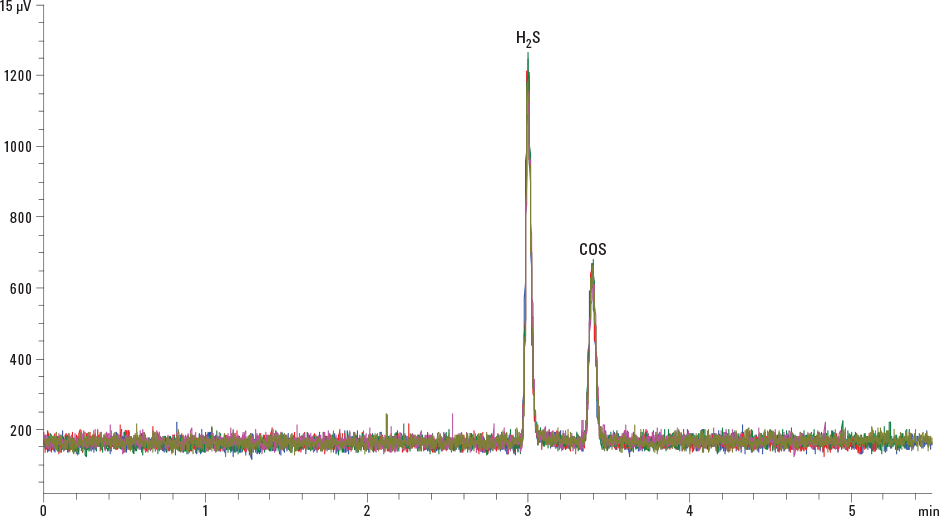Access Agilent eNewsletter April 2016

Optimized detection of gaseous sulfur compounds using Agilent J&W DB-Sulfur SCD GC column and Inert Flow Path
Yun Zou, Hua Wu and Chunxiao Wang, Agilent GC Applications
To protect expensive catalysts and ensure product quality, sulfur compounds must be monitored in gaseous fuels and gasoline. The analysis of gaseous sulfur compounds is challenging because they are polar, reactive, and present in widely varying concentrations. The analysis of liquid sulfur compounds in gasoline is likewise challenging because they can occur in very complex matrices and often in widely varying concentrations. The Agilent J&W DB-Sulfur SCD GC column, with low bleed and exceptional inertness, is specifically developed for sulfur compound analyses and is optimized for gas chromatography (GC) with a sulfur chemiluminescence detector (SCD).
The Agilent SCD is an excellent device for sulfur compound analysis because its response is inherently linear, equimolar, and relatively insusceptible to hydrocarbon interferences. ASTM Method D5504 [1] uses a SCD for the detection of sulfur compounds in gaseous fuels and natural gas. Likewise, ASTM Method D5623-94 uses a SCD for the detection of sulfur compounds in gasoline. [2]

Figure 1. Chromatograms of natural gas (A) and natural gas after desulfurization (B) illustrate the wide dynamic range provided by the Agilent sulfur chemiluminescence detector.

Figure 2. Chromatogram of major sulfur compounds at 15 ppb demonstrates column resolution and inertness, as well as detector sensitivity.
Low-bleed, inert column is essential
To avoid decreases in sensitivity, the SCD requires use of low-bleed GC columns to avoid fouling of SCD ceramics. In addition, volatile sulfur compounds are highly reactive and have adsorptive and metal-catalytic properties. Therefore, analysis of sulfur compounds requires that sample pathways—especially the GC column—be inert to ensure reliable results.
Agilent Application Note 5991-4643EN demonstrates the performance of the Agilent J&W DB-Sulfur SCD column and an Agilent Inert Flow Path GC/SCD for analysis of sulfur compounds in petroleum gases and natural gas. The column was configured with a volatiles interface inlet and SCD to measure the total sulfur in natural gas before and after desulfurization.
As shown in Figure 1, the concentration of some major sulfur compounds, especially H2S, varied greatly before and after desulfurization. You need a wide linear range (that is, from 10 ppb to 10 ppm) for major sulfur compounds. R2 correlation coefficients of the tested sulfurs in this study were better than 0.997.
Figure 2 shows the chromatogram of each major sulfur compound at a low 15 ppb level. Signal-to-noise ratios for H2S, COS, and DMS were 4.8, 11.2, and 9.3, respectively.
Excellent chromatography for polar and reactive sulfur compounds
Results of the study also showed that the column, with its low bleed and exceptional inertness, provided good resolution and symmetrical peak shapes for polar and reactive sulfur compounds. Hydrogen sulfide and carbonyl sulfide were baseline-separated at ambient temperature without cryogenic cooling. Excellent linearity, repeatability, and response for major sulfur compounds was achieved when using the Agilent J&W DB-Sulfur SCD column.

Figure 3. Overlay of six chromatograms of hydrogen sulfide and carbonyl sulfide at 2 ppm demonstrates consistent analyses.
Repeatable quantitative analyses
Agilent publication 5991-3108EN demonstrates analysis of gasoline samples with the Agilent DB-Sulfur SCD GC column. The test configuration included an Agilent Inert Flow Path split/splitless inlet, Ultra Inert liner, and Ultra Inert gold seal.
Repeatability analysis is based on six replicates of target sulfur compounds at various concentrations. Figure 3 shows good repeatability for hydrogen sulfide and carbonyl sulfide at 2 ppm, with a relative standard deviation (RSD) less than 3.5%.
Expect reliable results with Agilent solutions
The results show that the column provided good resolution and symmetrical peak shape for 18 sulfur compounds. In particular, hydrogen sulfide and carbonyl sulfide were separated at ambient temperature without cryogenic cooling. Good linearity and repeatability was achieved for all targeted compounds.
The combination of an Agilent Inert Flow Path, the Agilent J&W DB-Sulfur SCD column, and an Agilent sulfur chemiluminescence detector ensured accurate quantitative and qualitative analyses of sulfur compounds in petroleum samples.
For more information, watch this informative video about the Agilent J&W DB-Sulfur SCD GC column. Then contact your Agilent representative to order one today.
References
- ASTM D5504-12: Standard Test Method for Determination of Sulfur Compounds in Natural Gas and Gaseous Fuels by Gas Chromatography and Chemiluminescence. ASTM, Philadelphia, PA, USA (2012).
- ASTM D5623-94: Standard Test Method for Sulfur Compounds in Light Petroleum Liquids by Gas Chromatography and Sulfur Selective Detection. ASTM, Philadelphia, PA, USA (2014).
Stay informed about the applications that are important to you
Subscribe to Access Agilent
Our free customized
monthly eNewsletter
Article Directory – April 2016
All articles in this issue
 Analyze low-ppm levels of active sulfur compounds with inert sample path on the Agilent 490 Micro GC
Analyze low-ppm levels of active sulfur compounds with inert sample path on the Agilent 490 Micro GC Fast arsenic speciation for food and urine analysis with Agilent LC-ICP-QQQ
Fast arsenic speciation for food and urine analysis with Agilent LC-ICP-QQQ Simplify achiral-chiral analysis of warfarin metabolites using Agilent 2D-LC/MS solutions
Simplify achiral-chiral analysis of warfarin metabolites using Agilent 2D-LC/MS solutions Optimized detection of gaseous sulfur compounds using Agilent J&W DB-Sulfur SCD GC column and Inert Flow Path
Optimized detection of gaseous sulfur compounds using Agilent J&W DB-Sulfur SCD GC column and Inert Flow Path Oil-free laboratory vacuum eliminates oil mess and disposal costs
Oil-free laboratory vacuum eliminates oil mess and disposal costs Eliminate conventional SEC roadblocks with Agilent AdvanceBio SEC columns
Eliminate conventional SEC roadblocks with Agilent AdvanceBio SEC columns Fast, economical assessment of herbals with Agilent 1290 Infinity LC system and LC columns
Fast, economical assessment of herbals with Agilent 1290 Infinity LC system and LC columns Agilent 5977B GC/MSD with HES offers improved VOC detection limits
Agilent 5977B GC/MSD with HES offers improved VOC detection limits
Figure 1

Chromatograms of natural gas (A) and natural gas after desulfurization (B) illustrate the wide dynamic range provided by the Agilent sulfur chemiluminescence detector.
Figure 2

Chromatogram of major sulfur compounds at 15 ppb demonstrates column resolution and inertness, as well as detector sensitivity.
Figure 3

Overlay of six chromatograms of hydrogen sulfide and carbonyl sulfide at 2 ppm demonstrates consistent analyses.